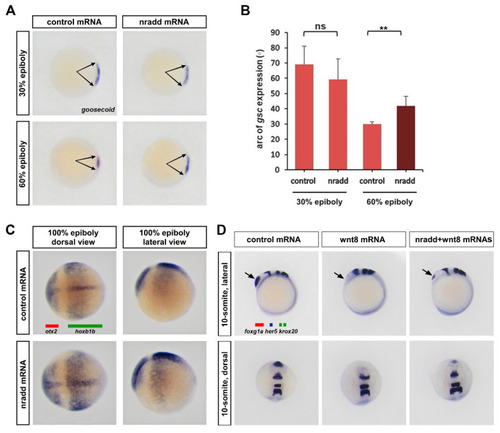Figure 3
- ID
- ZDB-FIG-210128-160
- Publication
- Ozalp et al., 2021 - Nradd Acts as a Negative Feedback Regulator of Wnt/β-Catenin Signaling and Promotes Apoptosis
- Other Figures
- All Figure Page
- Back to All Figure Page
|
nradd suppresses Wnt-mediated patterning of the mesoderm and the neuroectoderm. (A) nradd mRNA (250 pg) causes expansion of the dorsal organizer domain (arrows) marked by goosecoid (gsc) WMISH, not at late blastula (30% epiboly, n: control 23/23 embryos, nradd 26/29 embryos), but at early gastrula (60% epiboly, n: control 27/27 embryos, nradd 32/33 embryos) stage zebrafish embryos. Three independent experiments were conducted. (B) Quantification of gsc expression shown in (A) by measurement of arc degree (29 embryos in control 30% epiboly, 33 embryos in nradd 30% epiboly, 35 embryos in control 60% epiboly, 37 embryos in nradd 60% epiboly). Error bars are SD. ** indicates p < 0.01 and ns is non-significant. (C) nradd mRNA (250 pg) results in expansion of the anterior neuroectodermal marker otx2 (red bar) and a complementary reduction of the posterior neuroectodermal marker hoxb1b (green bar) defined by WMISH at the 100% epiboly stage (n: control 35/35 embryos, nradd 38/41 embryos). Three independent experiments were conducted. (D) nradd mRNA (250 pg) restores the telencephalon, marked by foxg1a (arrowhead), that is completely abolished by wnt8 mRNA (20 pg). WMISH is performed to detect expression of three independent RNAs, the forebrain marker foxg1a (red bar), the midbrain–hindbrain boundary marker her5 (blue bar) and the rhombomere 3/5 marker krox20 (two green bars) in zebrafish embryos at the 10-somite stage (n: control 33/33 embryos, wnt8 35/36 embryos, nradd+wnt8 42/45 embryos). Three independent experiments were conducted. |

